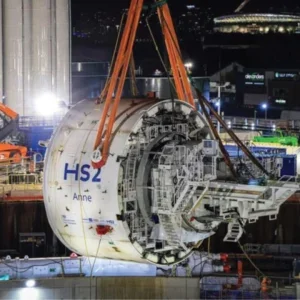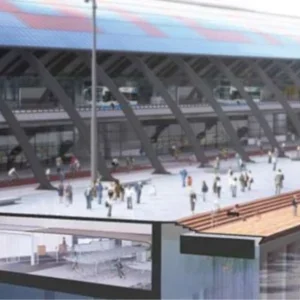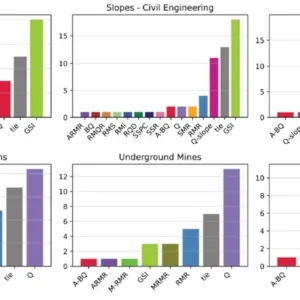The HS2 project is stepping forward with a variety of innovations as well as helping to lead at the forefront of larger-scale use of more sustainable approaches to using precast structural concrete in tunnel construction.
The UK’s new high-speed rail project, Phase 1 of which extends from London to Birmingham, and runs partly underground, has a series of bored tunnels being constructed in the Chilterns using segmental rings made of low carbon concrete. The segments are manufactured at a precasting factory built for the project.
HS2 is also constructing five ‘green’ tunnels that use less concrete than typical and are to blend into the landscape after their precast concrete frames are erected within cut-and-cover trenches and covered over. The panels of the first precast ‘green’ tunnel is under construction at Chipping Warden, in Northamptonshire.
SEGMENTAL CHOICE
Within Phase 1 of HS2, Lot C1 is the Chiltern Tunnel and Colne Valley Viaduct section involves mostly tunnelling. It was awarded in mid-2017 to Align JV, formed by Bouygues Travaux Publics, Sir Robert McAlpine and VolkerFitzpatrick. The lot includes a 21.6km long portion of the much longer high -speed route from near Coventry to the outskirts of London.
The Chiltern Tunnel section is 16.04km long and calls for a total of 16 043 concrete rings of 9.1m i.d. to be erected behind two 10.26m diameter Herrenknecht variable density slurry TBMs, ‘Florence’ and ‘Cecilia’, boring the twin tube tunnels. The 2m long rings (7, incl key) are formed of 400mm thick segments.
Tunnel lining design adopts a lower embodied carbon approach, reducing both the quantity of steel reinforcement and proportion of Ordinary Portland Cement (OPC). More than 90% of the Chiltern Tunnel segments are cast as steel fibre reinforced concrete (SFRC) and the mix design replaces a significant portion (40%) of OPC with ground granulated bast-furnace slag (GGBS).
A spokesman for HS2 says using SFRC uses approximately 70% less steel by weight in comparison to traditional reinforced concrete construction with rebar.
While the majority by far of the segments are standard SFRC, the project uses a hybrid design of steel fibres plus steel reinforcement bars (rebar) for specific zones of the tunnels, such as the mentioned cross passages, shafts and fault zones. There are a total of 1250 hybrid rings in the Chiltern tunnels.
Manufactured by Align JV, a total of 112 000 segments are to be cast at specially-built factory located at the launch (south) portal of the Chiltern TBMs. The factory casts and handles both the standard 4.5m long SFRC and hybrid segments, weighing 8.3 tonnes and 9.0 tonnes, respectively.
A year ago, the first TBMs were launched on the Chiltern tunnels – and on the project as a whole – from the south portal. Florence got underway first in May 2021 and slightly over 13 months later has advanced 4894m (2442 rings erected) through chalk and flints. A little over 11km remains to be built to reach the north portal.
Following Florence, her sister shield Cecilia, had by the start of July achieved 4619m (2304 rings erected) of progress after 12 months with approx 11.4km still to go. The shields are about halfway between Chalfont St Peter and Chalfont St Giles.
Farther south on HS2 route, in London, the concrete segments for the tunnels in the capital (Euston Tunnels and Approaches to Northolt Tunnels) are being manufactured at an existing precasting factory owned by Pacadar UK, on the Isle of Grain. The factory supplied prior major tunnelling projects, such Crossrail and Tideway, and was selected by the main contractor SCS – a JV of Skanska, Costain and Strabag. The factory is casting 350mm thick segments that will form 9.5m o.d. rings (7, incl key) installed behind 9.84m dia Herrenknecht TBMs.
GREEN LINES
Well under assembly is the 2.5km long Chipping Warden precast concrete tunnel, the first of five such ‘green’ structures that will be constructed for HS2 – and the first of three such cut-and-cover structures that will have panels made by Stanton Precast, based in Ilkeston, Derbyshire.
The off-site approach to large-scale concrete construction for the shallow tunnel has come from applying lessons won from successfully building the latest French high-speed rail lines, says HS2. Experience and lessons from those modular building projects, which allows for quicker and easier work on site, led to the approach being adopted for HS2 by the main contractor, EKFB – the group of Eiffage, Kier, Ferrovial and BAM Nuttall.
The contractor is undertaking main works along HS2 route immediately north of Chiltern Tunnel toward Long Itchington Wood, near Coventry. The green tunnels are the main underground works on the lot where the much of the infrastructure involves building viaducts and bridges as well as road diversions.
At Chipping Warden, the precast structure is a double-arch, one for each train direction, upline and downline. Each arch ‘ring’ is assembled from five panels, or segments – a central joining pier, two side walls and two roof slabs.
In a statement, HS2’s project client, Rohan Perin, said: “The off-site manufacturing techniques being used will help cutting the overall amount of carbon-intensive concrete and steel in the tunnel and make the whole process faster, more efficient and therefore less disruptive for the community.”
The modular assembly sits on a prepared reinforced concrete base slab, reinforced with rebar and running the length of the tunnel’s cut-and-cover wide shallow trench. At Chipping Warden, a total of 5020 segment panels are needed to build the required chain of modular ‘rings’ that form the long double-tunnel.
In a statement, EKFB’s project manager, Jeremie Martin, said the double-arch design “is more efficient than standard the box structure, reducing the amount of concrete required” and so help reduce carbon impact. The HS2 green tunnels are a first of their kind in the UK, added Martin.
Stanton Precast is delivering three of these tunnel designs, says a spokesman for HS2. “The other two will be different designs,” he adds.
Upon completion, the tunnel at Chipping Warden will be buried and landscaped to blend into the countryside, leaving only the portals as evidence of its presence.






